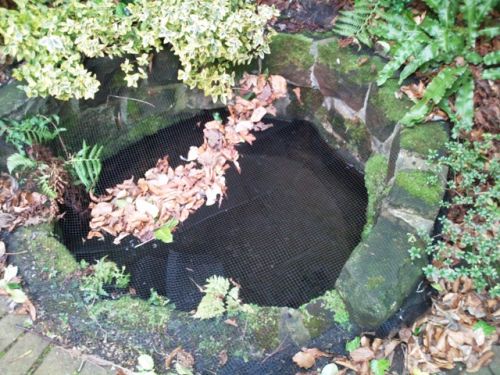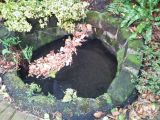Maiden's Well (Uttoxeter)
| Locality | |
|---|---|
| Coordinate | 52.8911, -1.8603 |
| Adm. div. | Staffordshire |
| Vicinity | 21 Highwood Road, c. 40 m S of Woodleighton junction; Uttoxeter |
| Type | Natural feature |
| Interest | Robin Hood name |
| Status | Extant |
| First Record | 1658 |
| A.k.a. | Maiden's Wall Well; Marian's Well; Mary's Well |

By Henrik Thiil Nielsen, 2020-10-18. Revised by Henrik Thiil Nielsen, 2022-06-17. Photo courtesy R. B. Parish.
Maiden's Well in Uttoxeter is now situated in a private garden, at 21 Highwood Road, Uttoxeter. It was formerly known as Marian's Well, or perhaps this was an alternative name; it was thus named already in 1658. A local historian suggested in 1886 that the element 'Marian' referred to Maid Marian.
As late as c. 1800 the Maiden's Well was still known locally for its healing waters as well as nightly visitations by the ghost of a beautiful young lady. Yet a couple of generations later, well, waters and wraith had all been largely forgotten. Writing in the 1860s to 1880s, Uttoxeter local historian Francis Redfern believed the well dated back to the time, if not of the Celts, then the Romans or at least the Anglo-Saxons (see Allusions below).[1] Modern archaeologists have expressed doubts about the antiquity of the well. Redfern had access to a 1658 survey of Uttoxeter in which the well was listed under the name 'Marian's Well', so it clearly was not of recent date, even if this does not make it ancient. In the mud near the well, Redfern found a stone with what he and a few other local gentlemen agreed must be an Ogham inscription.[2] In 1957 an archaeologist felt that this was 'probably a typical mis-identification of his period'.[3] No doubt 19th-century archaeology, in England as elsewhere, was often characterized by enthusiasm rather than method, yet it must be noted that the 1957 archaeologist clearly had not seen Redfern's stone.
In his first notice of the well, Redfern seemed inclined to think that the 'Maiden' in 'Maiden Well' must refer to the Virgin. In a paper published in 1873 he suggested a connection with the Roman road known as Maiden Way.[4] Then in 1886 he felt that '[f]rom the great celebrity of the well, the floral festivity of the Maid, Marian, the wife of Robin Hood, has probably been celebrated at it, from which circumstance it would readily and naturally receive the distinction of Marian's Well' (see 1886 allusion below). IRHB has seen no indication of spring or summer festivals in Uttoxeter and no certain example of a well, field or other minor locality anywhere acquiring a Robin Hood-related name on account of its being the venue for such festivals. Yet the form 'Marian's Well' is intriguing. 'Mary' would hardly develop naturally into 'Marian'. The latter used as an adjective in the sense 'relating to Mary (or Marius)' is a learned phenomenon and so hardly involved here. The survey of Uttoxeter consulted by Redfern dated from 1658, i.e. during the protectorate of either Oliver or Richard Cromwell, when much of the population was rather more puritanical than either protector. Puritans had a strong tendency to regard popular pastimes and festivals as noxious remnants of heathenism and idolatry, yet it seems possible they could have found '(Maid) Marian' more acceptable than 'Mary' as part of a place-name, and so perhaps 'Mary's Well' was changed to 'Marian's Well'. It must be noted that this explanation is pure speculation.
In 2011, a visitor to the well – which is in a private garden – described it as
The tithe award for the parish of Uttoxeter (1839) lists the plot in which the well is situated and two neighbouring plots as follows:
- Name or description: Maidens Wall Well Ground. Landowner: Joseph Sanders. Occupier: Adrian Woodings. State of cultivation: Pasture. Area: 4 acres and 25 perches (16819.75 m2)
- Name or description: Well Ground. Landowner: Joseph Sanders. Occupier: Adrian Woodings. State of cultivation: Pasture. Area: 5 acres, 1 rood and 17 perches (21675.97 m2)
- Name or description: Well Ground. Landowner: Joseph Sanders. Occupier: Adrian Woodings. State of cultivation: Meadows. Area: 3 acres, 2 rood and 16 perches (14543.39 m2).[6]
Allusions
1865 - Redfern, Francis - History of Town of Uttoxeter (2)
Another of these wells [in Uttoxeter] was called Marian's Well anciently, but in more modern times Maiden's Well, or Maiden's Wall Well (wall having the same meaning as well), and is situated on the ascent to the High Wood, by the road side, nearly opposite to the public-house there, but it has since been taken into the field. The waters of this well have also been famous for their virtues in healing; and the grandfather of an aged female living in Uttoxeter wished in his dying moments to have a bottle of water from it to drink, on account of its remarkable properties; so that its fame remained great until less than a hundred years back, although, perhaps, not six persons at this time, except by this notice, know any thing about it. But what is also remarkable about it is that it was believed to be haunted by the ghost of a handsome young lady, on account of which people were much afraid of going past it at night—a superstition origi- [p. 265:] nating, probably, in a former belief of the well having been inhabietd by spirits, there being superstitious beliefs of this kind in Scotland at this day.[7]
1886 - Redfern, Francis - History and Antiquities of Town of Uttoxeter (2)
[... an] interesting well, which is situated close to the road side on the High Wood, a little south of Balance Hill tollgate, on the left hand side, has the name of Maiden's Well, Maiden's Wall Well, and Marian's Well. I have previously attempted, when speaking of Roman ways, to show how it may have acquired the name of Maiden's Well. At the same time the name may be a corruption from Mai-din, a British word applied to a fort. It appears to have been notorious in Saxon times, from the Saxons having given it the name of Wall Well from the Latin, vallum, a wall. The well is now enclosed in a field, but formerly it was evidently open to the road, and a wide space of the bank side of the land has been removed on its account, and although this escarpment round or along the back of the well is much worn and broken, it [p. 348:] may have formed the vallum or wall, from which Wall Well is derived. From the great celebrity of the well, the floral festivity of the Maid, Marian, the wife of Robin Hood, has probably been celebrated at it, from which circumstance it would readily and naturally receive the distinction of Marian's Well.
Road side wells were particularly appreciated in Saxon days. Travelling being difficult and tedious, and there existing no houses of refreshment, way-side wells were of great importance and convenience. This was so much the case that Edwin, King of Northumbria, A.D. 628, had stakes driven down at them and a brazen dish affixed thereto with a chain, so that the fatigued way-farer might be enabled to refresh himself.
The waters of this well have always had a great reputation for their supposed healing virtues; and the grandfather of an aged female whom I knew, wished in his dying moments to have a bottle of water from it to drink, on account of its remarkable properties ; so that its fame remained great until less than a hundred years back, although, perhaps, not six persons at this time, except by this account, know anything about it. But what is remarkable respecting it is, that it was believed to be haunted by the ghost of a handsome young lady, on account of which people were much afraid of going past it at night — a superstition originating, probably, in a former belief of the well having been inhabited by spirits, there being superstitious beliefs of this kind in Scotland at this day.[8]
Gazetteers
- Not included in Dobson, R. B., ed.; Taylor, J., ed. Rymes of Robyn Hood: an Introduction to the English Outlaw (London, 1976), pp. 293-311
- Megalithic Portal: Maiden's Well – Holy Well or Sacred Spring in England in Staffordshire
- PastScape: Maidens Well.
MS sources
- 1839 tithe award for the parish of Uttoxeter, online at the Genealogist.com, Piece 32, sub-piece 218, Image 100, items #1007, #1009 and #1008 (£)
- accompanying map, online at the Genealogist.com, Piece 32, sub-piece 218, Sub-Image 002, items #1007, #1009 and #1008 (£).
Maps
- 25" O.S. map Staffordshire XXXII.2 (c. 1882; surveyed c. 1881). No copy in NLS
- 25" O.S. map Staffordshire XXXII.2 (1901; rev. 1900) (georeferenced)
- 25" O.S. map Staffordshire XXXII.2 (1901; rev. 1900)
- 25" O.S. map Staffordshire XXXII.2 (1922; rev. 1920)
- 25" O.S. map Staffordshire XXXII.2 (1939; rev. 1937)
- 6" O.S. map Staffordshire XXXII.NW (1884; surveyed 1881)
- 6" O.S. map Staffordshire XXXII.NW (1901; rev. 1899–1900) (georeferenced)
- 6" O.S. map Staffordshire XXXII.NW (1901; rev. 1899–1900)
- 6" O.S. map Derbyshire LII (1924; rev. 1920).
Background
Also see
Notes
- ↑ Also Redfern, F. 'On Uttoxeter and the Archæological Remains of the Parish and Neighbourhood', Journal of the British Archaeological Association, vol. XXIX (1873), pp. 263-78, see pp. 267, 270; Redfern, F. 'Additional Observations on Uttoxeter', Journal of the British Archaeological Association, vol. XXIX (1873), pp. 302-303, see p. 302.
- ↑ Redfern, F. 'On Uttoxeter and the Archæological Remains of the Parish and Neighbourhood', Journal of the British Archaeological Association, vol. XXIX (1873), pp. 263-78, see p. 270.
- ↑ PastScape: Maidens Well.
- ↑ Redfern, F. 'On Uttoxeter and the Archæological Remains of the Parish and Neighbourhood', Journal of the British Archaeological Association, vol. XXIX (1873), pp. 263-78, see pp. 267, 270; Redfern, F. 'Additional Observations on Uttoxeter', Journal of the British Archaeological Association, vol. XXIX (1873), pp. 302-303, see p. 302; Wikipedia: Maiden Way.
- ↑ Megalithic Portal: Maiden's Well – Holy Well or Sacred Spring in England in Staffordshire.
- ↑ 1839 tithe award for the parish of Uttoxeter, online at the Genealogist.com, Piece 32, sub-piece 218, Image 100, items #1007, #1009 and #1008 (£); accompanying map, online at the Genealogist.com, Piece 32, sub-piece 218, Sub-Image 002, items #1007, #1009 and #1008 (£).
- ↑ Redfern, Francis. History of the Town of Uttoxeter: with Notices of Places in its Neighbourhood (London; Uttoxeter; Derby, 1865), pp. 264-65.
- ↑ Redfern, Francis. History and Antiquities of the Town and Neighbourhood of Uttoxeter: with Notices of Adjoining Places. Second Edition (Hanley; London; Uttoxeter, 1886), pp. 347-48.
Image gallery
Click any image to display it in the lightbox, where you can navigate between images by clicking in the right or left side of the current image.
The Maiden's Well / Photo courtesy R. B. Parish, c. 3 Jan. 2011.


